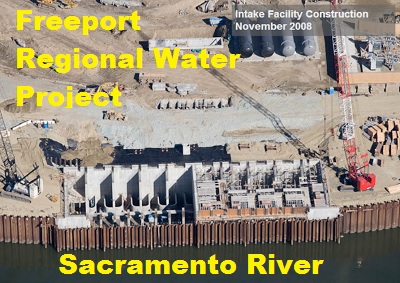Freeport, CA, April 22, 2014 – With little fanfare the pumps for a peripheral canal to ship water around the Sacramento – San Joaquin Delta were switched on for the first time. The local group Restore the Delta, who opposes both the peripheral canal and Bay Delta Conservation Plan tunnels, were baffled at how the peripheral canal pumps and facilities were even built, let alone that they had started pumping without them knowing about it. The initial water diversion calls for 16,000 acre feet to be pumped out of the Sacramento River, north of the town of Freeport, and sent around the Sacramento – San Joaquin Delta and delivered to reservoirs in the East Bay Municipal Utility District.
Sacramento River pumped into Delta peripheral canal
While the above report is somewhat fictitious, East Bay Municipal District did announce that they have started to pump out 16,000 acre feet to augment their drought depleted reservoirs in the Sierras. The entire Freeport Regional Water Project, which was jointly constructed by EBMUD and the City of Sacramento quite literally sends water around the Delta through a series of pipe lines, canals and pumping units. While northern California groups such as Restore the Delta work tirelessly to prevent any peripheral canal or tunnel project from being built, it’s already here.
EBMUD aqueduct discharges into Delta
East Bay Municipal Utility District aqueduct intersection north of Clifton Court Forebay.
The actual water delivery of the Freeport Regional Water Project is relatively small at 105 cubic feet per second (100 million gallons per day) and far less than the BDCP tunnel project that is estimated to have a maximum flow of 9,000 cubic feet per second. At this point, there is no outlet from the EBMUD’s massive pipe lines that travel through the Delta just north of the both the Central Valley Project and State Water Project. However, there is little stopping the construction of a facility at the intersection of the EBMUD aqueducts and Old River that would dump water into the delta. It is a short six miles from where the EBMUD aqueducts intersect Old River and the Clifton Court Forebay to the south where both the State Water Project and Central Valley Project pumps are located.
Peripheral canal emergency water
In the event of a massive failure of Delta levees and the inability of the existing structures such as the Delta Cross Canal to facilitate the transfer of fresh water from the Sacramento River through the Delta to Clifton Court Forebay, the Freeport Regional Water Project could provide very nominal water flows for the State Water Project. The state could install dams on Old River and Middle River to ensure that salt water intrusion from levee failures didn’t contaminate the water released from the EBMUD aqueducts.
Possible EBMUD peripheral canal discharge site on Old River in the Delta.
Delta peripheral water system operational
In its very essence, the Freeport Regional Water Project is a peripheral water conveyance system designed to have Bureau of Reclamation water purchased by EBMUD not pass through the Delta. Even though this water is being used to service East Bay communities, there is no reason that some simple modifications to the EBMUD aqueducts would allow the water to be sent south to Southern California. Perhaps the Metropolitan Water District in Southern California should fund the construction of the necessary modifications to allow the discharge of water from the EBMUD aqueducts in the event of an emergency situation where Sacramento River water can’t be conveyed through the Delta.
Will more water projects avoid the Delta?
2014 ushered in the operation of a peripheral water system that avoids water from Folsom Lake passing through the Delta to service East Bay communities. People and organizations that oppose the BDCP tunnels have to realize that absent state and federal funding or planning, local communities will find a way to circumvent moving water through the Delta. The more water that is allowed to avoid passing through the Delta correlates into less interest in spending money to preserve and enhance the Delta.
See also:
Comparing Delta tunnels to deep water shipping channel
